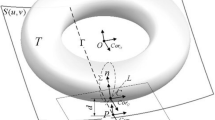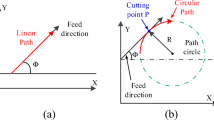Abstract
Sculptured parts are broadly used in the aeronautical, automotive, and die/injection mold industry. Both machining productivity and quality of sculptured surface are important for finish milling. Curvature radius as the most obvious characteristic of sculptured surface has the noticeable significant effect on them. Curvature radius affects the machining productivity as it is correlated with tool path selection (step length and path interval). In the meantime, curvature radius affects the machining quality by affecting cutting force, which has directly influence on the deformation of cutting tool system. Experimental result shows that, curvature radius especially the normal curvature radius ρ 2 which is perpendicular to the feeding direction on a CC point, has an obvious effect on machining productivity and quality.
Similar content being viewed by others
References
Peng YH, Yin ZW (2005) A new strategy for direct tool path generation from measured points. Int J Prod Res 43(5):933–944
Monreal M, Rodriquez CA (2003) Influence of tool path strategy on the cycle time of high-speed milling. Comput Aided Des 35(4):395–401
Bo HK, Choi BK (2002) Machining efficiency comparison direction-parallel tool path with contour parallel tool path. Comput Aided Des 34(2):89–95
Yin Z (2004) Rough and finish toolpath generation for NC machining of freeform surfaces based on a multi-resolution method. Comput Aided Des 36(12):1231–1239
Ding S, Mannan MA, Poo AN, Yang DCH, Han Z (2003) Adaptive iso-planar tool path generation for machining of free-form surfaces. Comput Aided Des 35(2):141–153
Anotaipaiboon W, Makhanow SS (2005) Tool path generation for five-axis NC machining using adaptive space-filling curves. Int J Prod Res 43(8):1643–1665
Kim GM, Kim BH, Chu CN (2003) Estimation of cutter deflection and form error in ball-end milling process. International Journal of Machine Tools & Manufacturing 43(9):917–924
Christophe T, Emmanuel D (2005) Iso-scallop tool path generation in 5-axis milling[J]. Int J Adv Manuf Technol 25(9–10):867–875
Fontaine M, Moufki A, Devillez A, Dudzinski D (2007) Modelling of cutting forces in ball-end milling with tool–surface inclination: part I: predictive force model and experimental validation. J Mater Process Technol 189(1–3):73–84
López de Lacalle LN, Lamikiz A, Sánchez JA, Salgado MA (2007) Toolpath selection based on the minimum deflection cutting forces in the programming of complex surfaces milling. International Journal of Machine Tools & Manufacture 47(2):388–400
Cao QY, Xue DY, Zhao J, Li YE (2011) A cutting force model considering influence of radius of curvature for sculptured surface machining. Int J Adv Manuf Technol 54(5–8):821–835
Kaymakci M, Lazoglu I (2008) Tool path selection strategies for complex sculptured surface machining. Mach Sci Technol 12(1):119–132
Lasemi A, Xue DY, Gu PH (2014) Tool path re-planning in free-form surface machining for compensation of process-related errors. Int J Prod Res 52(20):5913–5931
Suresh K, Yang DCH (1994) Constant scallop-height machining of free-form surfaces. ASME Journal of Engineering for Industry 116(2):253–259
Lin RS, Koren Y (1996) Efficient tool-path planning for machining free-form surfaces. ASME Journal of Engineering for Industry 118(1):20–28
Tournier C, Duc E (2002) A surface based approach for constant scallop height tool-path generation. Int J Adv Manuf Technol 19(5):318–324
Author information
Authors and Affiliations
Corresponding author
Rights and permissions
About this article
Cite this article
Cao, Q.Y., Zhao, J. & Zhu, L. The effect of curvature radius of sculptured surface on finish milling tool path selection. Int J Adv Manuf Technol 89, 3349–3357 (2017). https://doi.org/10.1007/s00170-016-9273-1
Received:
Accepted:
Published:
Issue Date:
DOI: https://doi.org/10.1007/s00170-016-9273-1




